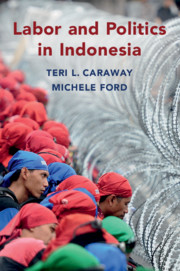Book contents
- Labor and Politics in Indonesia
- Cambridge Studies in Contentious Politics
- Labor and Politics in Indonesia
- Copyright page
- Contents
- Figures
- Tables
- Acknowledgments
- Abbreviations
- 1 Introduction
- 2 The Street and the Ballot Box
- 3 National and Local Policy Struggles, 1998–2008
- 4 Shifting to Offense
- 5 Local Executive Races
- 6 Legislative Contests
- 7 Building a Working-Class Constituency
- 8 Conclusion
- References
- Index
- Cambridge Studies in Contentious Politics
4 - Shifting to Offense
Published online by Cambridge University Press: 02 March 2020
- Labor and Politics in Indonesia
- Cambridge Studies in Contentious Politics
- Labor and Politics in Indonesia
- Copyright page
- Contents
- Figures
- Tables
- Acknowledgments
- Abbreviations
- 1 Introduction
- 2 The Street and the Ballot Box
- 3 National and Local Policy Struggles, 1998–2008
- 4 Shifting to Offense
- 5 Local Executive Races
- 6 Legislative Contests
- 7 Building a Working-Class Constituency
- 8 Conclusion
- References
- Index
- Cambridge Studies in Contentious Politics
Summary
This chapter focuses on the Indonesian labor movement’s increasingly assertive and offensive posture in the second decade after Suharto’s fall. At the national level, unions learned to lobby more effectively, generate favorable media attention, and leverage judicial institutions to complement street mobilization. They played a central role in the passage of a groundbreaking social security law. They made even greater strides at the local level, where they embarked on an unprecedented round of mobilizations around wages. Having consolidated their networks and their position on the wage councils, they transformed them into institutions that delivered sustained real wage gains. In doing so, they exploited the opportunities presented by direct local and provincial executive elections, leveraging electoral cycles, and harnessing regional patterns of wage-setting to win massive gains. Massive protests in several core industrial areas and stronger coordination among national confederations also allowed unions to nationalize local conflicts. Even after this support vanished, unions in some parts of Indonesia sustained substantial real minimum wage increases through their local organizing efforts.
Keywords
- Type
- Chapter
- Information
- Labor and Politics in Indonesia , pp. 70 - 94Publisher: Cambridge University PressPrint publication year: 2020



